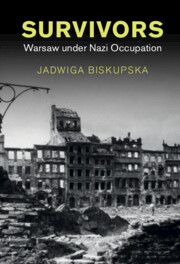Book contents
- Survivors
- Maps
- Studies in the Social and Cultural History of Modern Warfare
- Survivors
- Copyright page
- Dedication
- Contents
- Figures
- Acknowledgments
- Introduction
- 1 Warsaw Besieged
- 2 The Killing Years
- 3 Pawiak Prison
- 4 The Warsaw Ghetto
- 5 Information Wars
- 6 School of Hard Knocks
- 7 Matters of Faith
- 8 Spoiling for a Fight
- 9 Home Army on the Offensive
- Conclusion
- Bibliography
- Index
3 - Pawiak Prison
Published online by Cambridge University Press: 27 January 2022
- Survivors
- Maps
- Studies in the Social and Cultural History of Modern Warfare
- Survivors
- Copyright page
- Dedication
- Contents
- Figures
- Acknowledgments
- Introduction
- 1 Warsaw Besieged
- 2 The Killing Years
- 3 Pawiak Prison
- 4 The Warsaw Ghetto
- 5 Information Wars
- 6 School of Hard Knocks
- 7 Matters of Faith
- 8 Spoiling for a Fight
- 9 Home Army on the Offensive
- Conclusion
- Bibliography
- Index
Summary
Chapter 3, “Pawiak Prison,” places a spotlight on the main institution used to control the intelligentsia and their behavior: Pawiak prison. Nearly 100,000 “political criminals” – resisting elites, or those suspected of resistance – were held and tortured there between 1939 and 1944. The Warsaw Gestapo, working for Hans Frank’s General Government administration, utilized the former tsarist prison as a holding facility for Poles suspected of resistance to the occupation. It became symbolic of Nazi terror and hostility to the Polish national project, despite being confined behind the walls of the Warsaw Ghetto from fall 1940 on. The experience of confinement, mistreatment, and interrogation within the prison galvanized opposition projects for those who survived the experience. Nazi paranoia about potential Polish resistance kept Pawiak full and constant overcrowding demanded solutions: the mass execution of many prisoners, prisoner transfer to concentration camps in Nazi Germany, and the opening of a new concentration camp at Auschwitz to the southwest as an overflow facility. This chapter argues that Pawiak was both symbol and microcosm of how Warsaw’s German civilian and police administration attempted to control the Polish intelligentsia and its potential resisters after the killing campaigns concluded.
Keywords
- Type
- Chapter
- Information
- SurvivorsWarsaw under Nazi Occupation, pp. 80 - 104Publisher: Cambridge University PressPrint publication year: 2022

